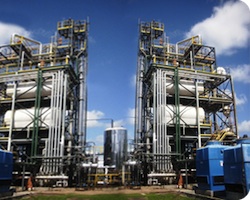Historically, 2009 was a hard year for biofuels. Biofuel spending was down to $5.6 billion from $15.4 billion in 2008. Investments in the industry focused on cellulosic technologies and sugarcane. This according to NRG Expert’s World Biofuels Report.
The report cites sugarcane-based biofuels as being the most competitive with oil and also have the lowest greenhouse gas emissions. The worst – biofuels produced from palm oil and soybeans. Fuel produced from either of these feedstocks do not meet EU  sustainability criteria. The highest investments were for technologies focused on developing biofuels from feedstocks such as jatropha and algae. Yet investments in jatropha are tapering off, according to the report, because research has shown it to perform poorly in field trials and consumes more water than expected.
sustainability criteria. The highest investments were for technologies focused on developing biofuels from feedstocks such as jatropha and algae. Yet investments in jatropha are tapering off, according to the report, because research has shown it to perform poorly in field trials and consumes more water than expected.
To court investments on the cellulosic side, the report says the technology must incorporate other core areas of business, such as developing biochemicals or high value products along with the production of the biofuel.
Moving in to 2012 and beyond, many biorefineries are operating below capacity due to the U.S. drought. Many mergers and acquisitions have taken place with many oil companies buying advanced biofuel technology. U.S. companies are having difficulty raising capital unless they are focused on the emerging Latin America or South East Asia markets.
While the report focuses on what has happened since 2009, it also looks at several strategies biofuel producers could employ to be more competitive in the tight investment market. For example, palm oil producers can retrofit by adding methane capture equipment to their plant as an effort to meet EU biofuel criteria and generate revenue selling electricity produced from methane.
The report predicts that raising oil prices will help biofuels be more competitive and new blending mandates could create a bigger market. In addition, more countries are expected to enter the sector on a commercial scale including Columbia, the Philippines and Thailand.

